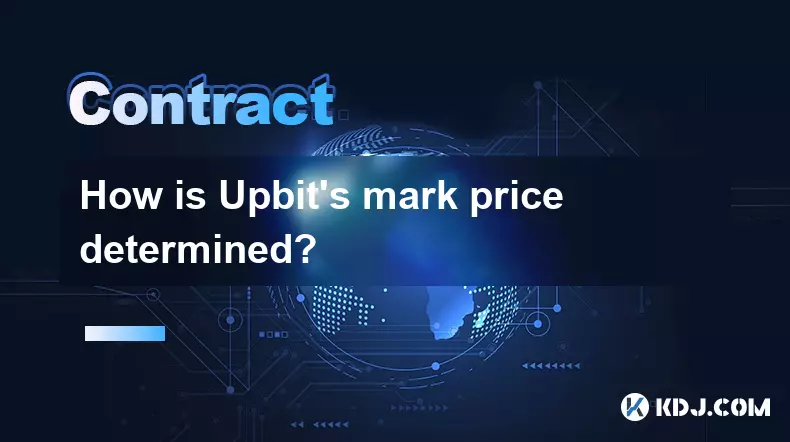-
 bitcoin
bitcoin $112195.049338 USD
2.42% -
 ethereum
ethereum $4124.915858 USD
2.81% -
 tether
tether $1.000570 USD
0.02% -
 xrp
xrp $2.861568 USD
2.25% -
 bnb
bnb $1000.346670 USD
3.04% -
 solana
solana $209.070819 USD
3.38% -
 usd-coin
usd-coin $0.999870 USD
0.02% -
 dogecoin
dogecoin $0.235379 USD
2.65% -
 tron
tron $0.335681 USD
-0.20% -
 cardano
cardano $0.803501 USD
3.38% -
 hyperliquid
hyperliquid $47.120881 USD
3.56% -
 chainlink
chainlink $21.501300 USD
3.44% -
 ethena-usde
ethena-usde $1.000571 USD
0.02% -
 avalanche
avalanche $29.793378 USD
3.62% -
 stellar
stellar $0.366964 USD
2.42%
How is Upbit's mark price determined?
Upbit's mark price uses a weighted index of trusted exchanges, time-weighted averages, and real-time safeguards to ensure fair, stable, and manipulation-resistant futures pricing.
Sep 18, 2025 at 11:36 am

Understanding Upbit's Mark Price Mechanism
1. Upbit determines the mark price for its perpetual futures contracts by using a composite index derived from multiple trusted external exchanges. This approach helps prevent manipulation and ensures fair valuation across markets. The index aggregates spot prices from leading platforms such as Binance, Coinbase, Kraken, and others that exhibit high liquidity and reliability.
2. The data used in calculating the mark price is time-weighted to minimize volatility spikes caused by sudden order book imbalances or flash crashes. By applying a time-weighted average price (TWAP) over a specific window—typically ranging between 30 seconds to several minutes—Upbit reduces the risk of erroneous liquidations due to short-term anomalies.
3. This methodology protects traders during periods of extreme market stress by anchoring the contract value to real-world spot valuations rather than relying solely on internal trading activity. In fast-moving markets, especially during news-driven events, maintaining alignment with broader market trends becomes essential for contract stability.
4. Upbit also incorporates safeguards like price deviation thresholds. If the last traded price on its platform diverges significantly from the calculated mark price, additional checks are triggered. These may include widening funding rate calculations or temporarily adjusting liquidation engines to reflect more conservative estimates.
5. Regular audits and transparency reports confirm that the index composition and weighting remain unbiased. Exchange selection is dynamic, meaning underperforming or compromised sources can be removed if they fail to meet predefined criteria related to uptime, volume consistency, and resistance to spoofing.
Data Sources and Weighting Strategy
1. The mark price relies on a weighted average model where each contributing exchange’s influence depends on its 24-hour trading volume and historical accuracy. Larger, more stable platforms receive higher weightings, ensuring the resulting index reflects dominant market sentiment.
2. Real-time APIs pull pricing data at frequent intervals, often every few hundred milliseconds, allowing for near-instantaneous updates. This frequency supports responsiveness without introducing excessive noise into the system.
3. To counteract potential latency issues, timestamps are synchronized across all source exchanges using network time protocols, ensuring temporal coherence in data aggregation. Discrepancies in timing could otherwise skew results, particularly during rapid price movements.
4. Exchanges showing abnormal spreads or prolonged stale prices are automatically downweighted or excluded until normal operations resume. This adaptive filtering enhances robustness against technical failures or coordinated attacks aimed at distorting reference values.
5. The full list of included exchanges and their respective weights is published periodically, enabling institutional users and algorithmic traders to validate inputs independently and align their risk models accordingly.
Role of Funding Rates and Liquidation Controls
1. While not directly part of the mark price calculation, funding rates on Upbit are influenced by the spread between the mark price and the last traded price. When this gap widens, periodic payments between long and short positions help incentivize convergence.
2. Liquidation engines use the mark price instead of the last traded price to determine margin requirements and trigger auto-deleveraging events. This prevents bad actors from exploiting thin order books to force unwarranted liquidations through spoofed trades.
3. By decoupling liquidation mechanics from potentially manipulatable market prices, Upbit strengthens trust in its derivatives infrastructure and promotes equitable treatment across all participants. This design is especially critical during low-liquidity hours when single trades might otherwise have outsized impact.
4. Insurance funds are calibrated based on historical deviations between mark and market prices, allowing the platform to absorb residual risks when forced exits occur under volatile conditions.
5. Margin adjustments and maintenance levels are recalibrated dynamically depending on observed volatility relative to the index, ensuring that position health remains consistent even when speculative fervor distorts local pricing.
Frequently Asked Questions
What happens if one of the source exchanges goes offline?If a contributing exchange becomes unreachable, its weight in the index is reduced proportionally while alternative sources are emphasized. Data continuity is maintained through fallback mechanisms, and no single exchange outage disrupts the overall integrity of the mark price.
Can traders access the raw data behind the mark price?Yes, Upbit provides API endpoints that expose both the composite index value and individual component prices. Traders can retrieve these feeds in real time to build custom monitoring tools or verify execution fairness.
Is the mark price updated continuously?The mark price is refreshed at regular intervals—typically every 1 to 5 seconds—depending on data availability and network load. Updates follow a push-based model, ensuring clients receive timely information without overwhelming systems.
Why doesn't Upbit use only its own spot prices?Relying solely on internal data would expose the platform to manipulation risks, including wash trading and quote stuffing. Using an external index neutralizes these threats and aligns derivative valuations with global market dynamics.
Disclaimer:info@kdj.com
The information provided is not trading advice. kdj.com does not assume any responsibility for any investments made based on the information provided in this article. Cryptocurrencies are highly volatile and it is highly recommended that you invest with caution after thorough research!
If you believe that the content used on this website infringes your copyright, please contact us immediately (info@kdj.com) and we will delete it promptly.
- PM Modi, RSS Centenary, and a Postage Stamp: A Curious Intersection
- 2025-09-29 18:45:12
- Ethereum ETF, Bitcoin ETF, and Investor Nerves: A New York Minute on Crypto
- 2025-09-29 18:25:14
- Ripple, Ondo Finance, and Tokenized Treasuries: A New Era for Institutional DeFi
- 2025-09-29 19:05:13
- Navigating the Crypto Seas: Federal Reserve, Bitcoin, and Interest Rate Tides
- 2025-09-29 18:25:14
- RSS Centenary: A Commemorative Coin and a Century of Impact
- 2025-09-29 18:45:12
- Avantis Crypto Price Crash Amidst Soaring Perpetual Volume: What's Going On?
- 2025-09-29 18:30:01
Related knowledge

How do I use the scheduled order feature in Cardano (ADA) contracts?
Sep 28,2025 at 10:18pm
Understanding Scheduled Orders in Cardano Smart ContractsCardano operates on a proof-of-stakes consensus mechanism and uses the Plutus scripting langu...

How do I enable the "scalping-only" mode for Cardano (ADA) contracts?
Sep 24,2025 at 03:19am
Understanding Scalping Strategies in Crypto Derivatives1. Scalping in cryptocurrency trading refers to executing multiple short-term trades within min...

What is the settlement time for Cardano (ADA) contracts?
Sep 28,2025 at 04:18am
Understanding Cardano's Contract Settlement Mechanism1. Cardano operates on a proof-of-stake consensus model known as Ouroboros, which fundamentally i...

How do I add margin to Cardano (ADA) contracts?
Sep 27,2025 at 07:54pm
Understanding Margin in Cardano (ADA) Smart ContractsCardano operates on a proof-of-stake blockchain that supports smart contracts through its Plutus ...

What is the maximum position limit for Cardano (ADA) contracts?
Sep 23,2025 at 11:00pm
Understanding ADA Futures and Derivatives Market Structure1. Cardano (ADA) futures contracts are offered by several major cryptocurrency derivatives e...

What is the maker fee for Cardano (ADA) contracts?
Sep 26,2025 at 09:01am
Understanding Maker Fees in Cardano (ADA) Contracts1. The concept of maker fees applies broadly across decentralized exchanges and smart contract plat...

How do I use the scheduled order feature in Cardano (ADA) contracts?
Sep 28,2025 at 10:18pm
Understanding Scheduled Orders in Cardano Smart ContractsCardano operates on a proof-of-stakes consensus mechanism and uses the Plutus scripting langu...

How do I enable the "scalping-only" mode for Cardano (ADA) contracts?
Sep 24,2025 at 03:19am
Understanding Scalping Strategies in Crypto Derivatives1. Scalping in cryptocurrency trading refers to executing multiple short-term trades within min...

What is the settlement time for Cardano (ADA) contracts?
Sep 28,2025 at 04:18am
Understanding Cardano's Contract Settlement Mechanism1. Cardano operates on a proof-of-stake consensus model known as Ouroboros, which fundamentally i...

How do I add margin to Cardano (ADA) contracts?
Sep 27,2025 at 07:54pm
Understanding Margin in Cardano (ADA) Smart ContractsCardano operates on a proof-of-stake blockchain that supports smart contracts through its Plutus ...

What is the maximum position limit for Cardano (ADA) contracts?
Sep 23,2025 at 11:00pm
Understanding ADA Futures and Derivatives Market Structure1. Cardano (ADA) futures contracts are offered by several major cryptocurrency derivatives e...

What is the maker fee for Cardano (ADA) contracts?
Sep 26,2025 at 09:01am
Understanding Maker Fees in Cardano (ADA) Contracts1. The concept of maker fees applies broadly across decentralized exchanges and smart contract plat...
See all articles










































































